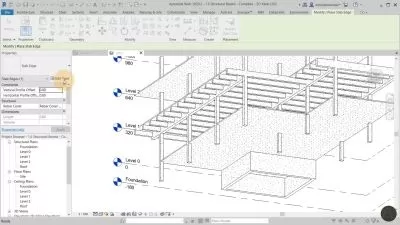Revit structures - Learn from Zero to Hero.
BIKI KUMAR DAS
2:54:39
Description
Modelling and analysis of an RCC building using Revit Structures
What You'll Learn?
- Proficiency in Revit Tools and Interface: Navigate the Revit interface fluently, understand toolbars, ribbons, and view controls
- Creation of Architectural Elements: Generate and modify architectural elements such as walls, floors, roofs, ceilings, doors, windows, and stairs.
- Building Information Modeling (BIM) Understanding: Comprehend the principles of BIM and apply them in architectural design workflows using Revit.
- Documentation Skills: Produce construction-ready drawings, schedules, and details efficiently within Revit.
- Collaboration Abilities: Collaborate with other disciplines (e.g., structural)) by linking and coordinating models in Revit.
- Design Development: Develop architectural designs from concept to detailed documentation stages using Revit's modeling and documentation tools.
- Rendering and Visualization: Create basic renderings and visualizations to communicate designs effectively
- Problem-Solving Skills: Develop the ability to troubleshoot and solve common issues and challenges encountered in Revit projects
Who is this for?
What You Need to Know?
More details
DescriptionRevit Structure is a powerful BIM software designed to assist structural engineers in creating detailed structural designs, workflows, schedules, documentation, and structural analysis. The course is suitable for structural engineers, engineering companies, and construction professionals.
Course Objectives
Understand the fundamentals of Building Information Modeling (BIM) for structural engineering.
Gain proficiency in using Revit's tools for creating and managing structural elements.
Learn to generate accurate structural designs and documentation efficiently.
Covers modeling structures, creating plans, analytical models, loads and reactions
Provides prepared files to follow along with the course progress
Benefits of Using Revit Structures
Improved Efficiency: By automating many aspects of the design and documentation process, Revit Structures helps engineers work more efficiently.
Enhanced Accuracy: The parametric nature of the software reduces errors and ensures that all elements of the design are coordinated.
Better Collaboration: The ability to work in a shared environment promotes better communication and collaboration among team members.
Regulatory Compliance: Revit Structures includes tools to help ensure that designs meet local building codes and standards.
In summary, Revit Structures is a comprehensive tool for structural engineering that enhances the design, analysis, and documentation processes through its integrated, parametric modeling capabilities, making it an essential software for modern structural design practices.
Who this course is for:
- Its for every Architects and Designers,Structural Designers,Students and Educators,Construction Professionals, civil Engineers
Revit Structure is a powerful BIM software designed to assist structural engineers in creating detailed structural designs, workflows, schedules, documentation, and structural analysis. The course is suitable for structural engineers, engineering companies, and construction professionals.
Course Objectives
Understand the fundamentals of Building Information Modeling (BIM) for structural engineering.
Gain proficiency in using Revit's tools for creating and managing structural elements.
Learn to generate accurate structural designs and documentation efficiently.
Covers modeling structures, creating plans, analytical models, loads and reactions
Provides prepared files to follow along with the course progress
Benefits of Using Revit Structures
Improved Efficiency: By automating many aspects of the design and documentation process, Revit Structures helps engineers work more efficiently.
Enhanced Accuracy: The parametric nature of the software reduces errors and ensures that all elements of the design are coordinated.
Better Collaboration: The ability to work in a shared environment promotes better communication and collaboration among team members.
Regulatory Compliance: Revit Structures includes tools to help ensure that designs meet local building codes and standards.
In summary, Revit Structures is a comprehensive tool for structural engineering that enhances the design, analysis, and documentation processes through its integrated, parametric modeling capabilities, making it an essential software for modern structural design practices.
Who this course is for:
- Its for every Architects and Designers,Structural Designers,Students and Educators,Construction Professionals, civil Engineers
User Reviews
Rating
BIKI KUMAR DAS
Instructor's Courses
Udemy
View courses Udemy- language english
- Training sessions 10
- duration 2:54:39
- Release Date 2024/11/19










